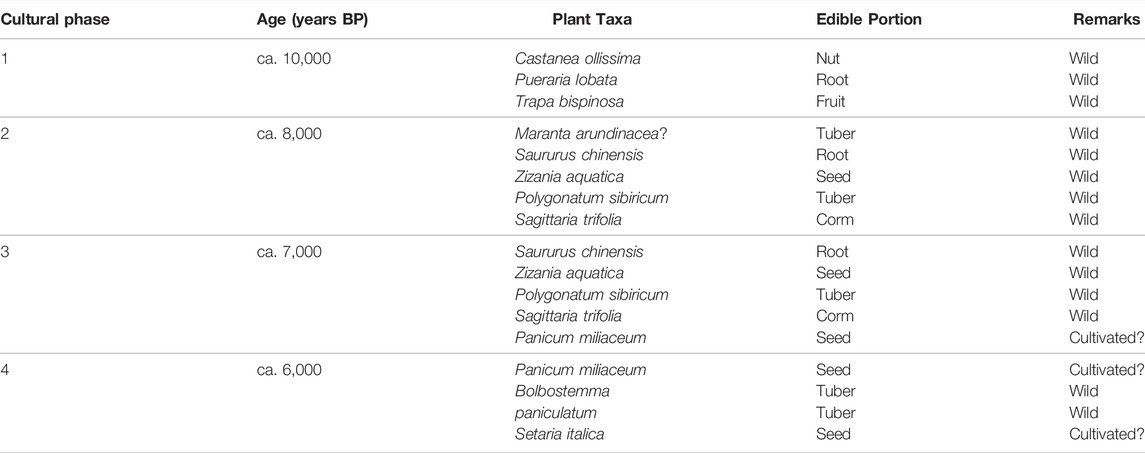- 1Key Laboratory of Vertebrate Evolution and Human Origins, Institute of Vertebrate Paleontology and Paleoanthropology, Chinese Academy of Sciences, Beijing, China
- 2University of the Chinese Academy of Sciences, Beijing, China
- 3CAS Center for Excellence in Life and Paleoenvironment, Beijing, China
- 4Institute of Archaeology, Chinese Academy of Social Sciences, Beijing, China
- 5School of Anthropology, University of Arizona, Tucson, AZ, United States
- 6Dingsishan Site Museum, Nanning, China
The Dingsishan Site, located in Nanning City, Guangxi Zhuang Autonomous Region, is one of the most important Neolithic archaeological sites in the Lingnan region of China’s southeastern seaboard. Plant microfossil remains recovered from excavated artifacts and human teeth suggest that the site’s ancient inhabitants practiced a subsistence system based on foraging. Wild plant food resources dominated their vegetal diet. Starch granules extracted from residue samples represent various taxa, including plant roots and tubers, aquatic plant fruits, beans, and wild cereals, defining the primary vegetal diet of Dingsishan’s Neolithic occupants. In addition, residue samples from shell artifacts yielded starch granules and phytolith remains, providing significant clues as to the function of these tools. We also identified millet starch granules from Dingsishan Cultural Phases 3-4 (ca. 7,000–6000 BP), albeit in extremely low quantities. Holocene paleoecological conditions in the Lingnan area provided diverse and plentiful wild food resources, allowing the relatively late emergence of agriculture. Our study suggests that Middle Neolithic human groups in the Yong River drainage consumed various plants, and their subsistence pattern was relatively stable through the four Cultural Phases identified at Dingsishan. Our conclusions enhance understanding the diversity of plant food resources exploited by foraging societies and interpretations of differences in patterns of agricultural origins in different ecological regions of China.
1 Introduction
The Lingnan area refers to the Nanling (or Wuling) Mountains and geographical areas to the south, mainly encompassing the Chinese province-level subdivisions of Guangdong, Guangxi, Fujian, and all administrative districts south of the Nanling Mountains. The Lingnan area today is a mixed subtropical and tropical monsoon zone characterized by a warm and humid climate with great biodiversity that is exceptionally plentiful. Abundant natural resources and a salubrious climate provided a favorable environment for the development of prehistoric human cultures. Ancient humans have occupied the Lingnan area since the Paleolithic period (>12,000 BP), forming prehistoric cultures with distinctive regional characteristics. Extensive archaeological fieldwork has been carried out in the Lingnan area since the 1930s, accumulating a substantial database (Gong and Gong, 2013). Early-Middle Neolithic cultural characteristics and sequence of development in the Lingnan area have long been important topics for scholars from many related disciplines.
The cultural behavior of prehistoric people is closely related to their ecological context. Neolithic cultural groups in the Lingnan region and neighboring Southeast Asia expressed complex and diverse subsistence patterns, which were quite different from those of contemporaneous cultures in the Chinese Central Plains and the middle-lower reaches of the Yangtze River (Han, 2012). A subtropical climate provided abundant and diverse biological resources for ancient people, facilitating the acquisition of animal and plant resources essential for human survival. However, this paleoecological situation also dampened the development of agriculture in the Lingnan area, where foraging subsistence systems based on hunting-fishing-gathering persisted well into the Holocene.
The economic strategies of prehistoric foragers in southern China and greater Southeast Asia, as well as the transition to agriculture in these regions, have been the subject of intensive investigation in recent years (Higham, 2013; Yang et al., 2013a; Cheng et al., 2018; Denham et al., 2018; Oxenham et al., 2018; Yang et al., 2018; Deng et al., 2019). Carbonized plant remains are essential evidence to facilitate discussion of the human use of ancient plant resources. However, moist and acidic subtropical soils in the Lingnan region often prevent plant remains from being well preserved. Evidence directly documenting the foodways of ancient people is very rare, thus hindering our understanding of the subsistence patterns of this area’s prehistoric inhabitants (Chen, 2016; Yu, 2018). These problems have thus far prevented the systematic and complete understanding of Early-Middle Neolithic Cultures in this area. As a result, plant microfossils become particularly important. Phytolith and starch granules in plants, especially, can provide solid evidence and support for the resolution of the questions outlined above.
Archaeological fieldwork conducted at the Dingsishan Site uncovered numerous artifacts and human remains, which has facilitated the application of multidisciplinary research approaches and provided a body of materials to enhance our understanding of the essential characteristics of Early-Middle Neolithic culture and ancient human economic activities in the Lingnan area (Fu et al., 1998; Fu, 2002). In our study, plant residue analysis was applied to materials unearthed from the Dingsishan Site. Starch remains from archaeological contexts at Dingsishan are fully described in this paper.
2 Archaeological Context
The Dingsishan Site (22°43′48″ N, 108°28′6″ E, ca. 70 m above mean sea level) is a well-preserved shell midden located on the first terrace of the right bank of the Bachi River, a tributary of the Yong River, approximately 3 km south of the Yongning District center, in the Guangxi Zhuang Autonomous Region, South China (Figure 1). The site was found in 1994 and excavated in 1997; subsequently, the Institute of Archaeology of the Chinese Academy of Social Sciences conducted excavations there between 1998–2000. The site extends over an area of roughly 5,000 square meters at present. Its stratigraphic profile is divisible into seven layers which yielded a total of 331 human burials and a large number of artifacts, including pottery, lithics, animal bones, and shell artifacts (Fu et al., 1998; Fu, 2002). Based on artifact typology, stratigraphic correlations, and chronological work conducted at adjacent archaeological sites, the Dingsishan cultural sequence can be roughly divided into four chrono-phases: Phase 1, ca. 10,000 BP; Phases 2-3, 8,000–7000 BP; and Phase 4, ca. 6000 BP (Fu et al., 1998; Chen, 2021). Artifacts unearthed from Phase 1 deposits include perforated stone tools and tektite flakes, as well as a small number of pottery sherds mixed with fine sand. Phases 2-3 are referred to as Dingsishan Culture, part of a complex of similar material culture widely distributed in southern Guangxi, especially in Yong River Valley, during the Early-Middle Neolithic. Human burials and substantial quantities of pottery, lithics, shell and bone artifacts were unearthed from these Dingsishan Culture layers. Various modes of human interment are known, especially the unique burial custom of dismemberment. Very few funerary objects were discovered in these graves. In Phase 4, the quantity of lithic artifacts decreases significantly over those of Phases 2-3 and shell implements disappear completely. Ceramic technology improved dramatically with the adoption of the potter’s wheel and higher firing temperatures (Fu et al., 1998; Fu, 2002).
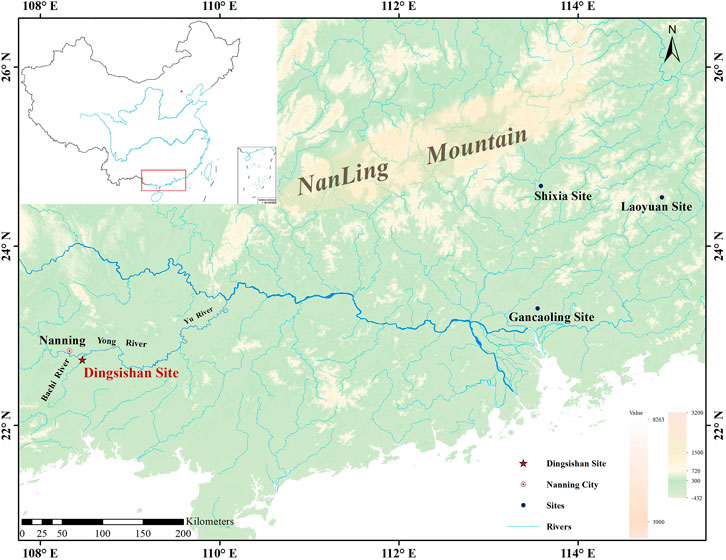
FIGURE 1. Geographic location of the Dingsishan site and other Neolithic Site mentioned in this paper.
3 Methods and Materials
3.1 Plant Residue Analysis
Plant microfossil residue analysis has been comprehensively applied in archaeology during recent years (McGovern et al., 2017; Prebble et al., 2019; Wang et al., 2019; Barber, 2020; Zhang et al., 2021; Guan et al., 2022). In our study, residue samples were collected from the surfaces of artifacts and human teeth unearthed from the Dingsishan Site. Human teeth were selected from 78 individuals unearthed from 76 graves belonging to Phases 2-4 (Fu et al., 1998) (Supplementary Table S1). The artifacts sampled derive from all the four phases. A total of 91 lithic, 20 shell, and 11 bone artifacts were selected for sampling. We collected both dental and artifact residue samples according to protocols established by Pearsall et al. (2004) and Guan et al. (2014). The residue samples comprise three sediments: Sediment I (Sed I), deposits attached to the surface of human teeth and artifacts; Sediment II (Sed II), liquid samples obtained by washing the specimens’ surfaces with distilled water; Sediment III (Sed III), liquid samples derived by ultrasonic cleansing of teeth and artifacts. Soil was rarely found adhering to dental specimens so only Sed III samples were collected in those cases.
Residue samples were gathered from different sediment-types for several reasons. Sed I samples reflect a micro-residue originating in soil, while Sed II samples, which are obtained by wet brushing, are thought to contain matter from both soil and the deep surfaces of the sampled specimens. The main aim of the wet brushing is to isolate Sed I and Sed III, to mitigate cross-contamination from Sed I to Sed III. In this case, Sed I samples are equally as important as Sed III samples since both can provide valid indications, while Sed II samples are difficult to analyze because they are, by definition, mixtures of multiple points of origination. Therefore, Sed II samples are not discussed further here. The taxa and amounts of starch granules in each sediment sample are used as indicators to evaluate which taxon/taxa were derived from soil contamination and which were formed as the result of ancient human behaviors.
Finally, 79 dental and 285 artifact residue samples were collected and processed in the Key Laboratory of Vertebrate Evolution and Human Origins of the Chinese Academy of Sciences in Beijing. The experimental process followed that of Guan et al. (2010), integrating several laboratory operations (Chandler-Ezell and Pearsall, 2003; Pearsall et al., 2004). Processing included the following steps: concentration, deflocculation, and heavy liquid flotation. Starch granule and phytolith extraction slides were observed with a Nikon Ni-E biological polarizing microscope. 100% glycerol was used as a mounting medium for starch and phytolith extractions. NIS-Elements D3.2 software was applied for the photography. Both phytolith and starch slides were viewed at 200–3×00 magnification and photographed at ×400 magnification.
3.2 Geometric Morphometric Analysis of Starch Granules
Geometric morphometry analysis has been widely used recently in many disciplines such as entomology, aquatic biology, medical science, paleoanthropolgy, and archeology (e.g,.Slice, 2007; Mitteroecker and Gunz, 2009; Addis et al., 2010; Webster and Sheets, 2010; Adams and Otárola-Castillo, 2013; Park et al., 2013; McNulty and Vinyard, 2015; Savriama, 2018) with accompanying advances in the anslysis of objects’ shapes. This method allows us to visualize differences among complex shapes with nearly the same facility. Moreover, it avoids the shortcomings of varying data sources, non-repeatability, and the size and shape data can be calculated altogether (Chen, 2017). The technological detail see Bookstein (1997) and Zelditch et al. (2004), thus will not be elaborated in this paper. In our study, 35 landmarks were assigned on each single starch granule, presenting the contour, location of hilum, and the extinction cross curvature of individual starch granule (Figure 2) (Zhang et al., 2021). Thin Plate Spline (TPS) files (landmark configurations) were imported into MorphoJ software (Klingenberg, 2011), for General Procrustes Analysis (GPA) and Canonical Variate Analysis (CVA). CVA assumes that the covariance structure within all groups is the same, therefore, a pooled within-group covariance matrix is used throughout for CVA and for computing distances between pairs of groups. The Mahalanobis distance matrix and Procrustes distance matrix may help explain group similarities and differences. In addition to CVA, our study also applied a supervised machine learning method to modern starch geometric morphometric data for model training (for technical details, see Zhang et al. (2021). In order to maximize the reliability of the machine learning model results, we adopted 95% accuracy as the standard of model usability, therefore, we regarded labels with an accuracy of 95% or more in the predicted results as valid, while labels with an accuracy of less than 95% were doubtful and are not presented here.
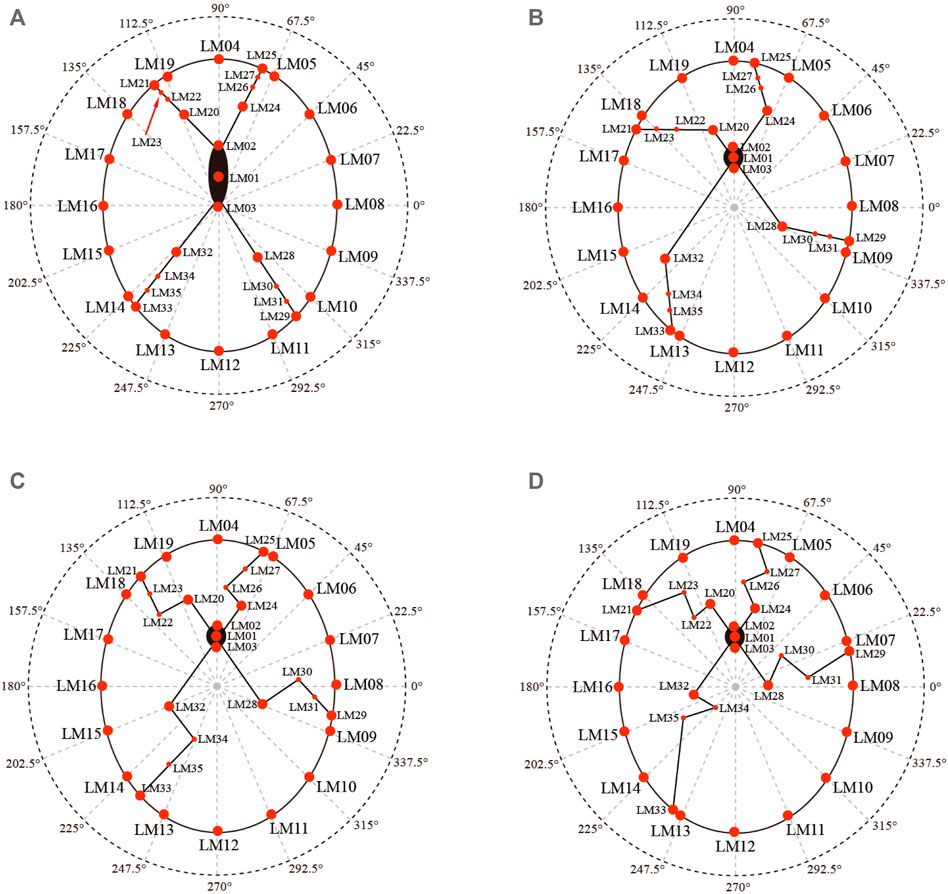
FIGURE 2. Definition of the 35 landmarks on starch granule. (A) Extinction cross with no bend; (B) each arm with one bend; (C) each arm with two bends; and (D), each arm with three bends (based on Zhang et al., 2021).
No matter what starch ideintification method is used, the contal groups, datasets derived from modern starch granules, are extremely essential (Figure 3). We have thus far compiled a modern reference database of more than 98 starch-producing taxa including both domesticated and wild taxa. For the geometric morphometric data extraction, some plants, such as certain species of Colocasia, produce extremely small (<5 μm) starch granules, and are thus inappropriate for the acquisition of landmark configurations. As a result, 57 taxa were included in our quantitative examination. Phytolith classification was based completely on published resources (Yang et al., 2009; Liu et al., 2011; Wan et al., 2011a; Wan et al., 2011b; Yang et al., 2013b; Yang and Perry, 2013; Liu et al., 2014; Wan et al., 2016; Liu et al., 2019; Ma et al., 2019; Li et al., 2020).
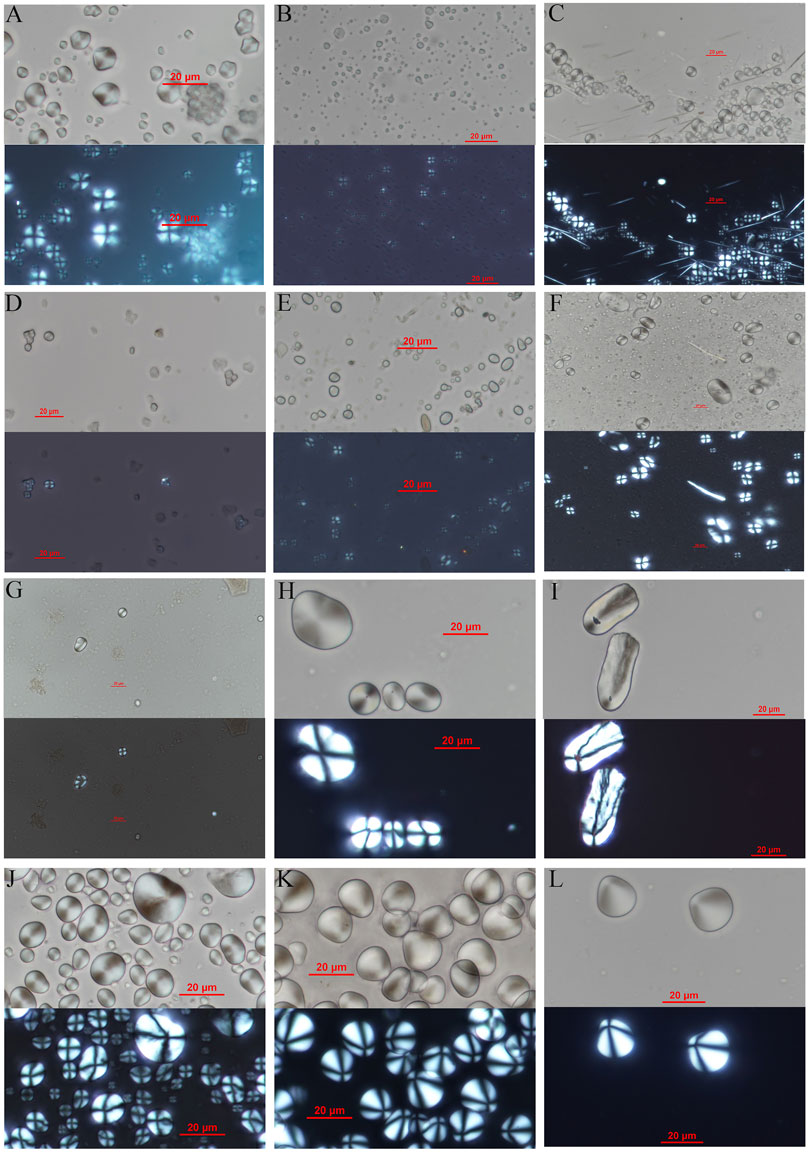
FIGURE 3. Modern plant starch references included in this paper. (A) Pueraria lobata (B) Amorphophallus virosus (C) Pinellia ternata (D) Zizania aquatica (seed) (E) Acorus tatarinowii (F) Canavalia gladiata (G) Vigna umbellata (H) Trapa bispinosa (I) Nelumbo nucifera (root) (J) Sagittaria trifolia (K) Bolbostemma paniculatum (L): Polygonatum sibiricum.
4 Results
Starch granules, phytoliths and small quantities of plant tissue fragments were revealed from the extracts (Table 1). Pollen, bordered pits, epidermal fibers and cells of unknown biological origin, and other organic fragments were also recovered from all three sediment types in extremely low frequencies and lacking distinguishing biological attributes, thus they are not included in this paper.
4.1 Starch Granule Analysis
A total of 887 starch granules was recovered from all three sediments types of residue samples (Figure 4), among which 32 were extracted from Sed I, 147 from Sed II, and 708 from Sed III (Table 1). Among these starch remains, 221 are seriously damaged or lack of identifiable features. Therefore, 666 granules (75.08% of the total) are examined in detail. We compared granules from Sed I with III by image comparison and geometric morphometric analysis to exclude contamination in Sed III, resulting in starch granules originating from human behavior during the occupation of the site.
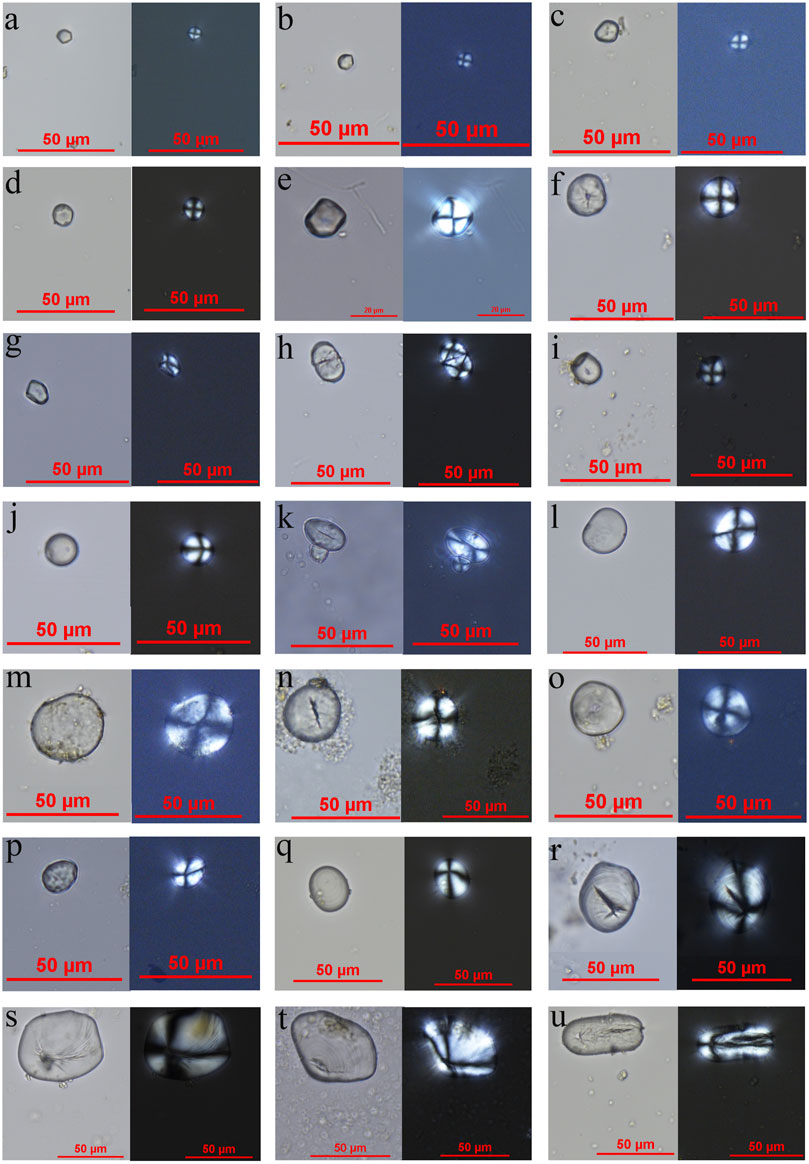
FIGURE 4. Starch granules from Dingsishan Sed III plant residue samples. (A) Polyhedron starch granule (B) Polyhedron starch granule (C) Polyhedron starch granule (D) Polyhedral spheroid starch granule (E) Polyhedron starch granule (F) Polyhedral spheroid starch granule (G) Polyhedron starch granule (H) Semi-ellipsoid starch granule (I) Bell-shaped starch granule (J) Ellipsoid starch granule (K) Ellipsoid starch granule (L): Ellipsoid starch granule (M): Ellipsoid starch granule (N): Drop-shaped starch granule (O): Ellipsoid starch granule (P): Drop-shaped starch granule (Q): Ellipsoid starch granule (R): Ellipsoid starch granule (S): Ellipsoid starch granule (T): Fan-shaped starch granule (U): Elongated-ellipsoid starch granule.
4.1.1 Morphological Classification
All recovered starch granules can be divided into the following categories by simple geometric and other visible characteristics:
Type 1, Semi-spheroidal, ellipsoidal, and elongated-ellipsoidal granules. The main two-dimensional shapes are oblong, ovate and irregular fan-shaped. The diameter range of these granules is 5.84–36.27 μm. This granule type always exhibits an eccentric hilum, remarkable lamellae and bent extinction crosses, therefore this type is easily distinguished from others. Granules of this type may be produced by roots and tubers of both terrestrial and aquatic plants.
Type 2, Polyhedral starch granules. The two-dimensional shapes are polygonal or circular with invisible lamellae, pronounced fissures and centric to slightly eccentric hilums, ranging 4.91–22.86 μm in size. Starch granules of this type were probably produced by Panicum sp., Setaria sp. (including wild species and domesticated species such as millet) and other Poaceae seeds. In addition, Figures 4K–M and o could be identified as the tribe Triticeae based on morphology and size (Yang and Perry, 2013). And the bell-shaped starch grains such as Figure 4I are mainly associated with roots and tubers in southern China, but some acorn, such as Cyclobalanopsis, contain similar starch grains, it is difficult to distinguish these granules according to traditional typology method. Therefore, more precise quantitative analytical methods are used in our project and the additional results are displayed at 4.1.2 (Wang, 2017).
Type 3, Polyhedral or spheroidal body with an extremely small diameter range. Most of the two-dimensional shapes are rounded polygons, and the rest are almost circular. These granules have smooth surfaces and invisible lamellae. No clear extinction cross or hila position can be observed due to the small size of the granule bodies. The diameter range of these granules is 4.25–9.18 μm. These starch granules resemble the morphology of modern specimens of the Araceae, according to our reference database (Figure 3B) and published literature (Wan et al., 2011a).
Type 4, Kidney bean shaped granules, which include starch from legumes (Family Fabaceae), ranging 8.56–17.28 μm in size. according to our modern reference database (Figure 3F) and published literature (Wang et al., 2013). These granules exhibit visible fissures and lamellae, with mostly invisible hilums. Furthermore, the center of the extinction crosses appears as a dark linear area and the extinction crosses themselves are “χ” shaped.
Type 5, Drop-shaped granules. This type features close and eccentric hila, visible lamellae and almost no fissures. The two-dimensional shapes are mostly tri-rounded corners ovoids or drop-shaped ovoids. The diameter range of these granules is 6.75–26.52 μm. According to recent studies (Yang et al., 2009), starch granules probably derive from Quercus acorns and, especially, nuts of the Chinese chestnut, Castanea mollissima.
This classification does not effectively assess the differences between Sed I and III, thus more precise quantitative analytical methods are needed.
4.1.2 Geometric Morphometric Analysis and Evaluation of Contamination
Landmark configurations of all recovered starch granules were applied to CVA and machine learning algorithm analysis. The distribution of canonical variates (CVs) showed that the geometric morphometric characteristics of starch granules in Sed I and Sed III defined two peak values (Figure 5), and the Mahalanobis distance also showed apparent differences between the groups (p value < 0.0001), suggesting different dominant sources of the two samples. In this case, most of the starch granules from Sed III are considered the result of human use of artifacts and chewing food. For a better understanding, we displayed the canonical variates calculated from Sed III starch granules and modern starch granules on a two-dimensional scatter plot, thereafter, compared the overlap scatters to infer which plant taxa the Sed III starch granules belong to. Scatter plot results of CVA with confidence ellipses (probability = 0.95) (Figure 6) reflect a clustered relationship and distribution region that may be formed by geometric data of different types of starch granules, and provide important reference data for further distinguishing starch granule groups with obvious or unique morphological characteristics. However, the results presented here cannot cover all the canonical variates simultaneously and, as a result, we cannot quantitatively count and analyze species information on starch granules according to CVA data, and the mathematical distance between groups does not support detailed classification of starch granules in a more quantitative way. In order to present more accurate and specific recognition results and exlude soil contamination in Sed III samples, a SVM model was applied from which a list was acquired (Table 2), suggesting taxa possibly derived from soil sediments.
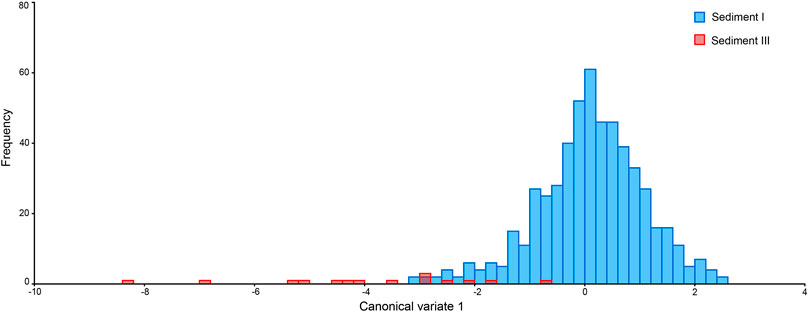
FIGURE 5. Canonical variable frequency bar chart of Sed I and Sed III samples from the Dingsishan Site.
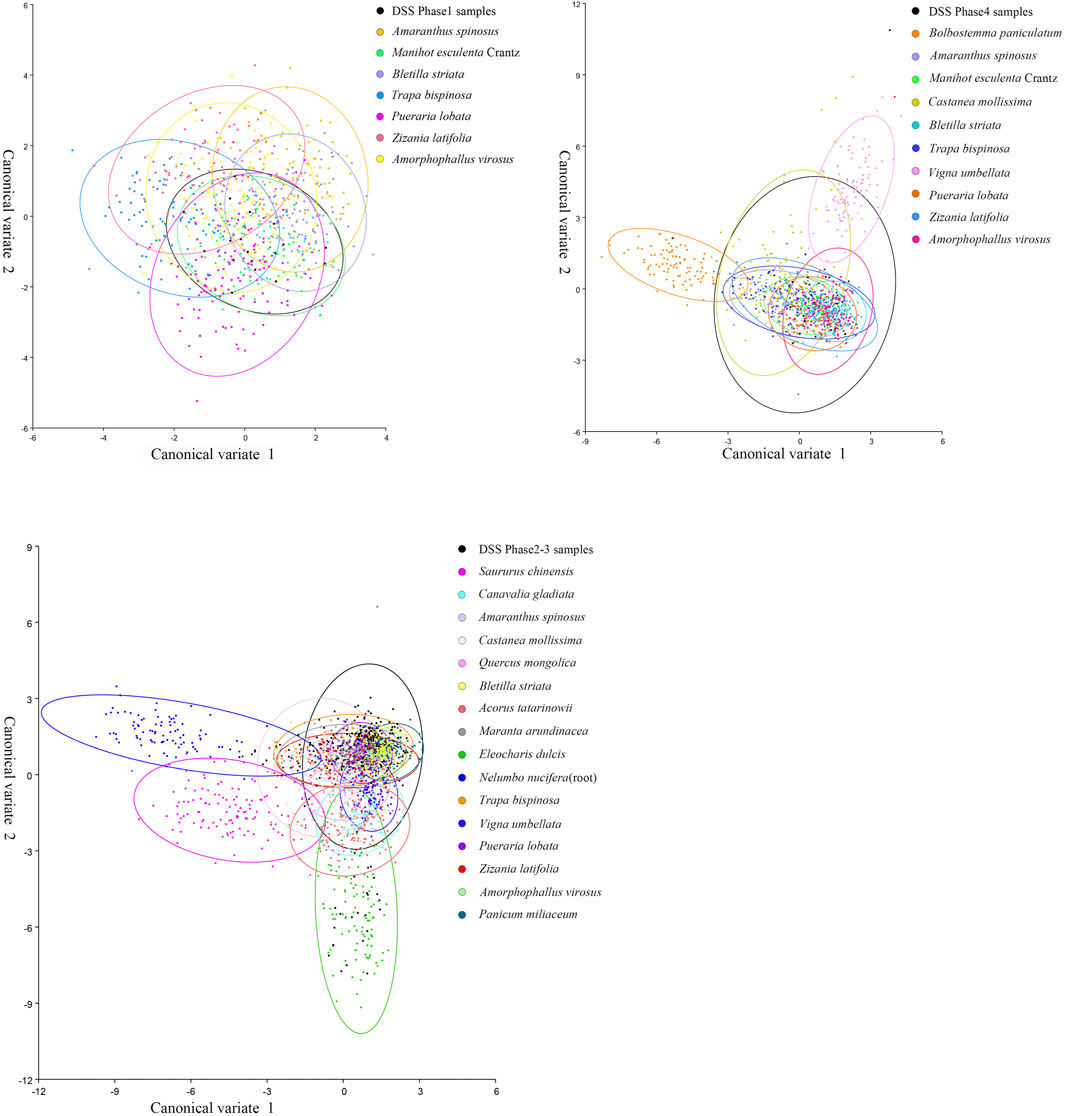
FIGURE 6. Confidence ellipses (probability = 0.95) based on Canonical Variate scatter plot of CV1 and CV2.
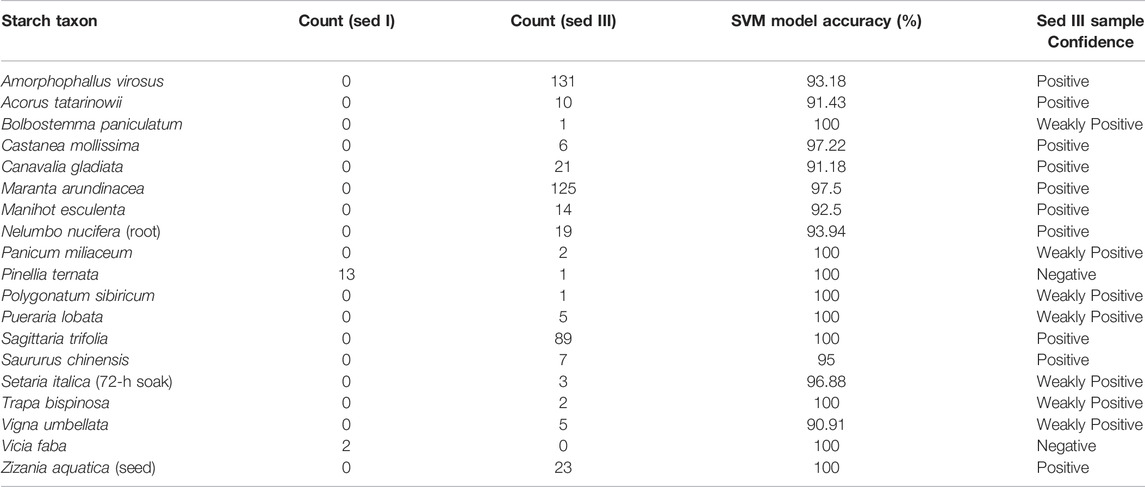
TABLE 2. Extrapolated identification of archaeologically-derived starch granules from the Dingsishan Neolithic site.
These results establish that Castanea mollissima, Bolbostemma paniculatum, Maranta arundinacea, Panicum miliaceum, Polygonatum sibiricum, Pueraria lobata, Sagittaria trifolia, Saururus chinensis, Setaria italica, Trapa bispinosa, and Zizania aquatica may be considered positive taxa (model accuracy ≥95%) (Table 3), among which wild species dominate the assemblage. These taxa are regarded as indicators of human activity during the period of the site’s occupation. The taxa possibly derived from soil will not be discussed below.
One issue should be considered that, the size of starch granules is an important index when identifying foxtail millet and broomcorn millet (Yang et al., 2012). In view of its low quantity, and weakly positive in geometric morphometric analysis, we suggest to consider the five granules of foxtail and broomcorn millets as the subfamily Panicoideae.
4.1.3 Starch Taxa Associated With Different Cultural Stages at Dingsishan
As previously stated, the Dingsishan archaeological deposit can be separated into four cultural stages, among which Phases 2-3 are defined as Dingsishan Culture. In consequence, positively identified Sed III starch granule taxa are categorized into six groups according to cultural stage and specimens sampled: 1) artifacts from Cultural Phase 1 (A01); 2) artifacts from Cultural Phase 2 (A02); 3) artifacts from Cultural Phase 3 (A03); 4) artifacts from Cultural Phase 4 (A04); 5) human teeth from Cultural Phase 2-3 (T02-03); and 6) human teeth from Cultural Phase 4 (T04). SVM predictions for each group (see Table 3) suggest that the Dingsishan starch granules (n = 465) likely derive from terrestrial plant roots and tubers (58.49%), aquatic plants (32.26%), legumes (6.67%), nuts (1.29%) and cereal grains (Panicoideae seeds) (1.08%). The Panicoideae seeds were present only in Phase 3 and 4 at low percentages. Cultural Phase 1 shows a pattern distinguishable from Phase 2 and 3. Wild taxa represented are mainly subtropical species, among which Manihot esculenta (cassava or manioc) and Maranta arundinacea (arrowroot) are not native to China. They appear on the list of identified species because, in the process of determining unknown starch granules, the SVM model searched for the most similar subset in the control group and output the label of that most similar group for the unknown starch granules. This does not mean that these two plants are actually Manihot esculenta and Maranta arundinacea but, rather, that their starch granule morphologies are highly similar to those taxa. Due to the great diversity of plants in Guangxi, our modern starch database does not include all the wild root and rhizome resources that may have existed during the Neolithic period, thus this problem occurs. One way to solve this problem is to expand the scale of the control group and provide more accurate predictive models in future work.
4.2 Phytolith Remains and Plant Tissue Fragments
At Dingsishan, 235 phytoliths from tooth samples and 641 phytoliths from three stratigraphic levels of artifacts were recovered (Figure 7). In summary, 816 specimens were extracted from Sed III samples. These phytoliths were classified into eight types based upon criteria provided by Lu et al. (2006) including Elongate, Fan-shaped, Saddle, Square, Bilobate short cells, Cylindrical polylobate, Globular echinate and other irregular-shaped. Fan-shaped and Elongate forms appeared most frequently, suggesting these phytoliths might belong to the Bambusoideae (bamboos), Palmae (palms), or Chloridoideae (tropical and sub-tropical grasses) taxonomic groups. We also identified several unknown taxa with conspicuous morphological characteristics. Phytolith analysis failed to yield evidence of cultivation, indicating that foraging may have been the most sustainable subsistence pattern for Dingsishan’s Neolithic inhabitants.
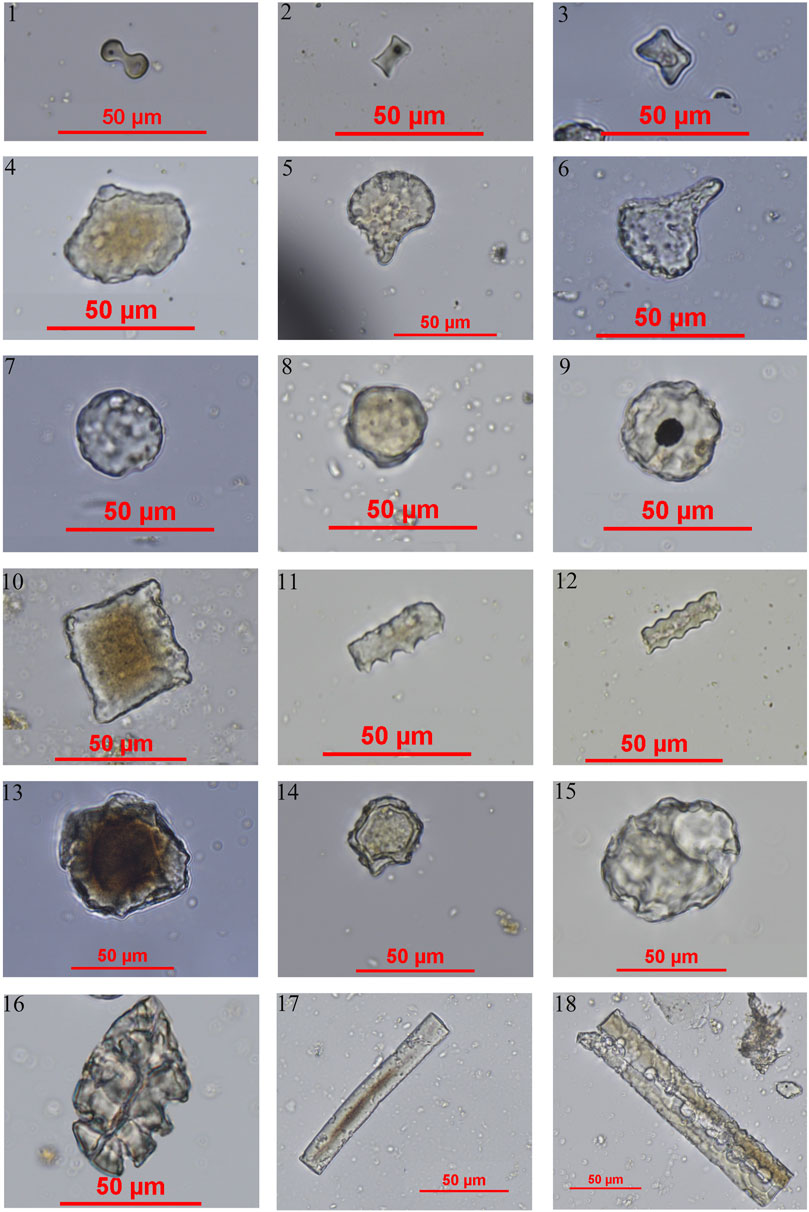
FIGURE 7. Phytoliths recovered from Dingsishan plant residues. 1. Bilobate 2–3. Short cell (Two-spiked rondels) 4–6. Bulliform cells 7–9. Globular echinate 10. Rectangle 11. Elongate echinate; 12. Elongate sinuate 13–16. Polyhedron from wood 17. Smooth elongate 18. Elongate from wood.
5 Discussion
In this study, starch granules and other plant microfossils extracted from human dental remains and artifacts provide considerable evidence for exploring human diet and subsistence patterns at Dingsishan. We suggest that the Neolithic inhabitants of the site utilized underground storage organs as their primary source of vegetal food (Table 4). Roots and tubers, rich sources of energy, are usually easy to gather and process, and are thus one of the most common plant food resources exploited in both prehistoric and modern times. Fruit of the aquatic plant, Trapa bispinosa (water caltrop) and tubers of Sagittaria trifolia (Chinese arrowhead) are rich in starch, which can provide the necessary energy for human survival. Nuts and grains also occupy a place in human plant recipes, but in relatively low percentages. In addition, in terms of the identifiable starch number among all the results, except for Amorphophallus virosus, Maranta arundinacea, and Sagittaria trifolia, the identifiable quantity of other plant species is tiny under the strictly statistical standards, which limits our discussion about how Dingsishan people consume and utilize these plants.
The utilization of wild plant resources was an essential part of ancient human subsistance behavior for millennia at Dingsishan, throughout all four Cultural Phases. However, during Cultural Phases 3 and 4, Panicoideae seeds evidenced by the starch remains are present, while this discovery shows low quantity (n = 5) and weakly positive characteristic in geometric morphometric analysis, it surely suggesting a subtle change during Cultural Phase 3. Therefore, current evidence is insufficient to determine whether cultivation behavior leading to the subsequent millet agriculture appeared at that time. Nevertheless, these data may indicate that Dingsishan’s Neolithic occupants were in a transitional period of plant resource utilization during Cultural Phases 3-4 when they attempted to intensify the utilization of seed plants, paying greater attention to the acquisition and utilization of cereal grain resources than previously.
It is noteworthy that 315 starch granules in Sed III were extracted from shell knives (or spatulas), which accounted for 59.4% of the total starch granule yield from artifacts (n = 530) in Sed III. Taxonomically identifiable starch granules recovered from shell implements came mainly from roots and tubers, perhaps indicating that implements such as shell knives were used mainly for gathering and processing roots and tubers. Scholars have argued that South China may have been a relatively stable tropical agricultural zone with roots and tubers constituting the principal cultivated crops (Li, 1990; Zhao, 2006). However, carbonized or otherwise preserved roots and tubers are rarely found in archaeological contexts due to the high moisture and acidity of tropical soils. It is difficult to demonstrate the existence of root- and tuber-based agriculture based on the quantity of plant remains available for study. Morphological standards for distinguishing domesticated root and tuber remains are still unclear, which limits our ability to provide extensive discussion of this issue. Our results suggest that roots and tubers existed for a long period (Phases1-4) at Dingsishan, and in larger proportions.
A foraging strategy dominated subsistence systems in the Lingnan region for a long period during the Early-Middle Neolithic. Previous studies have proposed that rice agriculture and planting techniques were introduced into this area from the Middle and Lower Yangzi Valley about 5,000–4000 BP (Zhang and Hung, 2009; Chi and Hung, 2012). Currently, the earliest direct evidence of rice agriculture in the Lingnan region comes from the Shixia and Laoyuan sites in Guangdong Province where carbonized rice grains have been dated directly to 4,347–4,090 and 4,419–4,246 Cal BP, respectively (Yang et al., 2017; Yang et al., 2018). Moreover, Deng et al. (2022) published their new discovery of Gancaoling Site, for where the ancient human cultivated rice together with a small portion of foxtail millet around 4,800–4,600 cal. BP. So far, no clear evidence of early agriculture at contemporaneous sites farther south in the Yong River Valley in Guangxi has been detected; the earliest evidence of rice agriculture in Guangxi is a diagnostic Oryza phytolith found at Dingsishan in Cultural Phase 4 deposits (Zhao et al., 2005). However, our study detected no clear evidence of rice farming, such as rice phytoliths and starch, which may be a function of the number and type of samples selected for analysis. Since the distribution of plant residues is random, and the microfossils which attached to artifacts and human teeth are easily destroyed by human activities and the preservation condition, we suppose that the different source of samples selected by us and Zhao et al. (2005) led to the different results. Current archaeological evidence and our research suggest that Phase 4 at Dingsishan was probably a transitional period with respect to human subsistence patterns (Chen, 2016). Therefore, plant remains associated with Dingsishan Phase 4 are considered significant evidence for exploring this transformation. We expect accumulating follow-up research results to clarify this critical transition to developed agriculture.
The Guangxi Zhuang Autonomous Region, where the Dingsishan Site is located, is bisected by the Tropic of Cancer and is bordered by tropical seas to the south, the Nanling Mountains to the north, and the Yunnan-Guizhou Plateau to the west. Mountains and hills dominate the terrain. Numerous rivers, abundant water resources, and a complex coastline are all typical. The region has a warm climate with high average annual rainfall and sunshine amounts. The average annual temperature is 17.5–23.5°C. According to paleoclimatic and paleoenvironmental studies conducted in Guangxi (e.g., Li, 1998; Zhang et al., 2000; Zhang et al., 2003), the Lingnan region began to enter a warming period in the early Holocene about 10,000 years ago, during which various plants, especially broad-leaved species, rhizomes and herbs, greatly increased, providing abundant fruits, green leaves and tubers for human consumption. Our results indicate that such wild plant resources were crucial to the prehistoric occupants of Dingsishan. They apparently gathered and consumed wild plant resources such as roots and tubers, beans and aquatic plants, nuts and grains, indicating the extensive use of diverse plant resources. Roots and tubers are usually easy to gather and process; thus, they are considered one of the most common food resources in both prehistoric and modern times. Aquatic plants are widely distributed in the subtropical zone. For Dingsishan’s prehistoric inhabitants, living as they did along a river, obtaining such resources was very time- and labor-efficient, with a high resource return rate. Nuts and grains also occupied a place in plant recipes, but the proportions of these two plant resources are relatively low. Our analysis confirms that the Lingnan region’s hydrothermal conditions and natural environment fostered a level of biodiversity that gave the region’s ancient inhabitants ready access to diverse food sources and delayed the process of agricultural development.
6 Conclusion
We identified several types of plant starch from Dingsishan plant residue samples. Geometric morphometric analysis indicates that these starch granules might derive from plant underground storage organs, aquatic plant fruits and tubers, and a small number of nuts and cereals. These plant micro-remains reflect the diversity of the vegetal food resources exploited by the Lingnan region’s prehistoric inhabitants between roughly 10,000 and 6,000 years ago. Terrestrial plant roots and tubers, and aquatic plant edible parts occupy the most crucial position in the diet structure of human beings during various cultural periods. In brief, gathering was the principal means by which prehistoric humans obtained plant food resources.
Dingsishan is the best-preserved Early-Middle Neolithic shell midden site yet discovered in Guangxi. It provides important information to enhance our understanding of the cultural characteristics and chronology of prehistoric Guangxi and the greater Lingnan region. Conducting a systematic study of the animal and plant remains in this site can reveal the unique economic patterns of prehistoric people in the Lingnan region and provide better understanding of regional diversity and common developmental trajectories of prehistoric human subsistence patterns.
What pathways did the emergence and development of agriculture in prehistoric South China follow? This question has been common among archaeologists for the past several decades. Today, many scholars are still focused on reconstructing the processes of subsistence change in their entirety. Plant residue analysis provides a unique perspective to enhance discussions of these issues. Archaeobotanical studies tend to concentrate on evidence of specialized agricultural food production, and such research has focused predominantly on data regarding farming economies, while problems such as the use of plant foods in hunter-gatherer contexts and how foraging peoples obtained and cultivated plant foods are discussed less or such discussions are at least limited by a relative paucity of substantiating evidence. Research on plant micro-remains from archaeological contexts needs to continuously accumulate, embracing the latest investigative technology and information efficiently and comprehensively to inexorably establish an effective and comprehensive interpretive database.
Data Availability Statement
The original contributions presented in the study are included in the article/Supplementary Material, further inquiries can be directed to the corresponding author.
Author Contributions
XZ: Conceptualization, Methodology, Software, Investigation, Formal Analysis, Writing - Original Draft; CH, ZZ and QH: Resources, Supervision; JO: Writing - Review andamp; Editing; YG: Conceptualization, Funding Acquisition, Supervision, Writing - Review andamp; Editing.
Funding
This research was supported by the Strategic Priority Research Program of the Chinese Academy of Sciences (Grant Nos. XDB26030404), and National Key R&D Program of China (2020YFC1521500). Olsen’s participation was supported by the Chinese Academy of Sciences President’s International Fellowship Initiative (PIFI) (Award No. 2018VCA0016) and the University of Arizona’s Je Tsongkhapa Endowment for Central and Inner Asian Archaeology.
Conflict of Interest
The authors declare that the research was conducted in the absence of any commercial or financial relationships that could be construed as a potential conflict of interest.
Publisher’s Note
All claims expressed in this article are solely those of the authors and do not necessarily represent those of their affiliated organizations, or those of the publisher, the editors and the reviewers. Any product that may be evaluated in this article, or claim that may be made by its manufacturer, is not guaranteed or endorsed by the publisher.
Acknowledgments
We express our sincere appreciation to the Institute of Archaeology, Chinese Academy of Social Sciences for supporting our research. We are grateful to the Germplasm Bank of Wild Species in the Kunming Institute of Botany, Chinese Academy of Sciences, for providing many seed specimens for modern starch granule preparation. We thank Prof. FU Xianguo of the Institute of Archaeology, Chinese Academy of Social Sciences, for providing samples and supporting our research. We also thank KONG Chuan’e, NI Yangyang, and LIANG Li, for their support and assistance in our laboratory work.
Supplementary Material
The Supplementary Material for this article can be found online at: https://www.frontiersin.org/articles/10.3389/feart.2022.879908/full#supplementary-material
References
Adams, D. C., and Otárola-Castillo, E. (2013). Geomorph: Anrpackage for the Collection and Analysis of Geometric Morphometric Shape Data. Methods Ecol. Evol. 4, 393–399. doi:10.1111/2041-210X.12035
Addis, P., Melis, P., Cannas, R., Secci, M., Tinti, F., Piccinetti, C., et al. (2010). A Morphometric Approach for the Analysis of Body Shape in Bluefin Tuna: Preliminary Results. Collective Volume Scientific Pap. 65, 982–987.
Barber, I. G. (2020). Further Wet-Taro Evidence from Polynesia's Southernmost Neolithic Production Margins. Proc. Natl. Acad. Sci. U.S.A. 117, 1257–1258. doi:10.1073/pnas.1918374117
Bookstein, F. L. (1997). Landmark Methods for Forms without Landmarks: Morphometrics of Group Differences in Outline Shape. Med. Image Anal. 1 (3), 225–243. doi:10.1016/s1361-8415(97)85012-8
Chandler-Ezell, K., and Pearsall, D. M. (2003). Piggyback Microfossil Processing: Joint Starch and Phytolith Sampling from Stone Tools. The Phytolitharien 15, 2–8.
Chen, W. (2016). Research on Neolithic Chronologies andSubsistential Strategies of Lingnan Area. Unpublished Ph.D. dissertation. Changchun: Jilin University.
Chen, W. (2021). Zailun "Huanan zaoqi Xinshiqi 14C niandaishuju yinqi de kunhuo" wenti (Discussion on the issue of the confusion caused by the 14C Dates of Early Neolithic remains from South China again) (in Chinese). Wenbo 4, 42–50. doi:10.3969/j.issn.1000-7954.2021.04.005
Cheng, Z., Weng, C., Steinke, S., and Mohtadi, M. (2018). Anthropogenic Modification of Vegetated Landscapes in Southern China from 6,000 Years Ago. Nat. Geosci 11, 939–943. doi:10.1038/s41561-018-0250-1
Chi, Z., and Hung, H.-c. (2012). Later hunter-gatherers in Southern China, 18 000-3000 BC. Antiquity 86, 11–29. doi:10.1017/S0003598X00062438
Deng, Z., Hung, H.-c., Li, Z., Carson, M. T., Huang, Q., Huang, Y., et al. (2019). Food and Ritual Resources in hunter-gatherer Societies: Canarium Nuts in Southern China and beyond. Antiquity 93, 1460–1478. doi:10.15184/aqy.2019.173
Deng, Z., Huang, B., Zhang, Q., and Zhang, M. (2022). First Farmers in the South China Coast: New Evidence from the Gancaoling Site of Guangdong Province. Front. Earth Sci. 10, 858492. doi:10.3389/feart.2022.858492
Denham, T., Zhang, Y., and Barron, A. (2018). Is There a centre of Early Agriculture and Plant Domestication in Southern China? Antiquity 92 (365), 1165–1179. doi:10.15184/aqy.2018.156
Fu, X., Li, X., Li, Z., Zhang, L., and Chen, C. (1998). Guangxi Yongningxian Dingsishan yizhi de fajue (Discovery of Dingsishan Site in Yongning County, Guangxi) (in Chinese). Archaeology 11, 11–33. CNKI:SUN:KAGU.0.1998-11-001.
Fu, X. (2002). The Dingsishan Site and the Prehistory of Guangxi, Southern China. Bull. Indo-Pacific Prehistory Assoc. 22, 63–72.
Gong, W., and Gong, Q. (2013). Huanan Xinshiqi shidai zaoqi wenhuayicun de faxian ji xiangguan wenti de tantao (Discovery and discussion of Early Neolithic Cultural remains in South China) (in Chinese). Shiqian Yanjiu, 125–150.
Guan, Y., Pearsall, D. M., Gao, X., and Zhou, Z. (2010). Shizhipin zhiwu canliuwu fenxi de shiyanshi fangfa yi Shuidonggou shizhipin weili (Plant residue analysis method of stone artifacts in the laboratory: Based on the Shuidonggou lithic materials) (in Chinese). Acta Anthropologica Sinica 29, 395–404.
Guan, Y., Pearsall, D. M., Gao, X., Chen, F., Pei, S., and Zhou, Z. (2014). Plant Use Activities during the Upper Paleolithic in East Eurasia: Evidence from the Shuidonggou Site, Northwest China. Quat. Int. 347, 74–83. doi:10.1016/j.quaint.2014.04.007
Guan, Y., Wang, C., Zhou, Z., Cheng, J., Cao, J., Ta, L., et al. (2022). Evidence from Plant Starch Residues of the Function of Early Pottery and the Plant Diet of Neolithic Inhabitants of Inner Mongolia, North China. Quat. Int. 608-609, 215–225. doi:10.1016/j.quaint.2020.10.010
Han, J. (2012). Zhongguo Xinshiqishidai zaozhongqi wenhua de quxi yanjiu (Research of Cultural Regions from Early-Middle Neolithic in China) (in Chinese). Kaoguxue Yanjiu, 24–36.
Higham, C. (2013). Hunter-gatherers in Southeast Asia: from Prehistory to the Present. Hum. Biol. 85, 21–43. doi:10.13110/humanbiology.85.1-3.0021
Klingenberg, C. P. (2011). MorphoJ: an Integrated Software Package for Geometric Morphometrics. Mol. Ecol. Resour. 11, 353–357. doi:10.1111/j.1755-0998.2010.02924.x
Li, W., Pagán‐Jiménez, J. R., Tsoraki, C., Yao, L., and Van Gijn, A. (2020). Influence of Grinding on the Preservation of Starch Grains from rice. Archaeometry 62, 157–171. doi:10.1111/arcm.12510
Li, F. (1990). Shilun Huanan diqu yuanshinongye de qiyuan (The origin of primitive agriculture in South China) (in Chinese). Nongye Kaogu 2, 84–95.
Li, W. (1998). Zhongguo Disiji Zhibei Yu Huanjing (Quaternary Vegetation and Environment in China) (In Chinese). Beijing: Science Press.
Liu, Z., Wang, L., Zhou, W., Chen, Y., and Wang, Z. (2011). The Surface of the Geometric Characteristics Analysis for rice Endosperm Starch Granules by Using Image J (In Chinese). J. Chin. Electron Microsc. Soc. 30, 466–471. doi:10.3969/j.issn.1000-6281.2011.04.035
Liu, L., Duncan, N. A., Chen, X., and Cui, J. (2019). Exploitation of Job's Tears in Paleolithic and Neolithic China: Methodological Problems and Solutions. Quat. Int. 529, 25–37. doi:10.1016/j.quaint.2018.11.019
Liu, L., Ma, S., and Cui, J. (2014). Identification Of Starch Granules Using A Two-Step Identification Method. J. Archaeol. Sci. 52, 421–427. doi:10.1016/j.jas.2014.09.008
Lu, H.-Y., Wu, N.-Q., Yang, X.-D., Jiang, H., Liu, K.-b., and Liu, T.-S. (2006). Phytoliths as Quantitative Indicators for the Reconstruction of Past Environmental Conditions in China I: Phytolith-Based Transfer Functions. Quat. Sci. Rev. 25, 945–959. doi:10.1016/j.quascirev.2005.07.014
Ma, Z., Perry, L., Li, Q., and Yang, X. (2019). Morphological Changes in Starch Grains after Dehusking and Grinding with Stone Tools. Sci. Rep. 9, 2355. doi:10.1038/s41598-019-38758-6
McGovern, P., Jalabadze, M., Batiuk, S., Callahan, M. P., Smith, K. E., Hall, G. R., et al. (2017). Early Neolithic Wine of Georgia in the South Caucasus. Proc. Natl. Acad. Sci. U.S.A. 114, E10309–E10318. doi:10.1073/pnas.1714728114
McNulty, K. P., and Vinyard, C. J. (2015). Morphometry, Geometry, Function, and the Future. Anat. Rec. 298, 328–333. doi:10.1002/ar.23064
Mitteroecker, P., and Gunz, P. (2009). Advances in Geometric Morphometrics. Evol. Biol. 36, 235–247. doi:10.1007/s11692-009-9055-x
Oxenham, M. F., Trinh, H. H., Willis, A., Jones, R. K., Domett, K., Castillo, C., et al. (2018). Between Foraging and Farming: Strategic Responses to the Holocene Thermal Maximum in Southeast Asia. Antiquity 92, 940–957. doi:10.15184/aqy.2018.69
Park, P., Aguirre, W., Spikes, D., and Miyazaki, J. (2013). Landmark-based Geometric Morphometrics: What Fish Shapes Can Tell Us about Fish Evolution. Tested Studies for Laboratory Teaching. Proc. Assoc. Biol. Lab. Educ. 34, 361–371.
Pearsall, D. M., Chandler-Ezell, K., and Zeidler, J. A. (2004). Maize in Ancient Ecuador: Results of Residue Analysis of Stone Tools from the Real Alto Site. J. Archaeological Sci. 31, 423–442. doi:10.1016/j.jas.2003.09.010
Prebble, M., Anderson, A. J., Augustinus, P., Emmitt, J., Fallon, S. J., Furey, L. L., et al. (2019). Early Tropical Crop Production in Marginal Subtropical and Temperate Polynesia. Proc. Natl. Acad. Sci. U.S.A. 116, 8824–8833. doi:10.1073/pnas.1821732116
Savriama, Y. (2018). A Step-by-step Guide for Geometric Morphometrics of floral Symmetry. Front. Plant Sci. 9, 1433. doi:10.3389/fpls.2018.01433
Slice, D. E. (2007). Geometric Morphometrics. Annu. Rev. Anthropol. 36, 261–281. doi:10.1146/annurev.anthro.34.081804.120613
Wan, Z., Yang, X., Ge, Q., and Jiang, M. (2011a). A. Morphological Characteristics of Starch Grains of Root and Tuber Plants in South China. Quat. Sci. 31 (4), 10. doi:10.3969/j.issn.1001-7410.2011.04.18
Wan, Z., Yang, X., Ma, Z., and Liu, G. (2011b). B. Morphological Change of Starch Grain Based on Simulated experiment and its Significance of Agricultural Archaeology - Taking Wheat as an Example. Agric. Sci. Tech. 12, 1621–1624. doi:10.3969/j.issn.1009-4229-B.2011.11.017
Wan, Z., Li, M., and Li, H. (2016). Study on Morphological Characteristics of Starch Granules in the Triticeae (In Chinese with English Abstract). J. Triticeae Crops 36, 1020–1027. doi:10.7606/j.issn.1009-1041.2016.08.07
Wang, Q., Jia, X., Li, M., and Yang, X. (2013). Zhongguo changjian doulei dianfenli xingtai fenxi jiqi zai nongyekaogu zhong de yingyong (The morphological analysis of common edible beans starch grains and the application in agricultural Archaeology) (in Chinese). Wenwu Chunqiu 2013, 3–11. doi:10.3969/j.issn.1003-6555.2013.03.001
Wang, J., Zhao, X., Wang, H., and Liu, L. (2019). Plant Exploitation of the First Farmers in Northwest China: Microbotanical Evidence from Dadiwan. Quat. Int. 529, 3–9. doi:10.1016/j.quaint.2018.10.019
Wang, W. W. (2017). The Utilization of Roots and Tubers in Prehistoric China. Undergraduate Dissertation. Beijing: University of Chinese Academy of Sciences.
Webster, M., and Sheets, H. D. (2010). A Practical Introduction to Landmark-Based Geometric Morphometrics. Paleontol. Soc. Pap. 16, 163–188. doi:10.1017/S1089332600001868
Yang, X., and Perry, L. (2013). Identification of Ancient Starch Grains from the Tribe Triticeae in the North China Plain. J. Archaeological Sci. 40, 3170–3177. doi:10.1016/j.jas.2013.04.004
Yang, X., Kong, Z., Liu, C., Zhang, Y., and Ge, Q. (2009). Characteristics of Starch Grains from Main Nuts in North China. Quat. Sci. 29 (1), 153–158. doi:10.1007/s11461-009-0031-5
Yang, X., Zhang, J., Perry, L., Ma, Z., Wan, Z., Li, M., et al. (2012). From the Modern to the Archaeological: Starch Grains from Millets and Their Wild Relatives in china. J. Archaeological Sci. 39 (2), 247–254. doi:10.1016/j.jas.2011.09.001
Yang, X., Barton, H. J., Wan, Z., Li, Q., Ma, Z., Li, M., et al. (2013a). Sago-Type Palms Were an Important Plant Food Prior to Rice in Southern Subtropical China. PLoS One 8 (5), e63148. doi:10.1371/journal.pone.0063148
Yang, X., Ma, Z., Li, Q., Perry, L., Huan, X., Wan, Z., et al. (2013b). Experiments with Lithic Tools: Understanding Starch Residues from Crop Harvesting. Archaeometry 56, 828–840. doi:10.1111/arcm.12034
Yang, X., Wang, W., Zhuang, Y., Li, Z., Ma, Z., Ma, Y., et al. (2017). New Radiocarbon Evidence on Early rice Consumption and Farming in South China. The Holocene 27 (7), 1045–1051. doi:10.1177/0959683616678465
Yang, X., Chen, Q., Ma, Y., Li, Z., and Hung, H. (2018). New Radiocarbon and Archaeobotanical Evidence Reveal the Timing and Route of Southward Dispersal of rice Farming in south China. Sci. Bull. 63, 43–49. doi:10.1016/j.scib.2018.10.011
Yu, C. (2018). Xinshiqi shidai zhi Qingtong shidai Lingnan ji zhoubiandiqu de shengye chutan (Preliminary research of subsistence patterns from Neolithic to Bronze Age in Lingnan and surrounding Area China) (in Chinese). Nanfang Wenwu 2, 180–187.
Zelditch, M., Swiderski, D., Sheets, H. D., and Fink, W. (2004). Geometric Morphometrics for Biologists: A Primer. New York and London: Elsevier Academic Press.
Zhang, C., and Hung, H. (2009). Huanan he Xinan diqu nongye chuxian de shijian ji xiangguanwenti (The time and issues of agricultural origin in South and Southwest China) (in Chinese). Nanfang Wenwu 3, 64–71.
Zhang, M., Lin, Y., Qin, J., and Li, B. (2000). The Formation Environment and Paleoclimatic Significance of No.1 Stalagmite in Xianshui Cave, Guanyang County, Guangxi. Geology-Geochemistry 1, 34–40.
Zhang, M., Yuan, D., Lin, Y., Qin, J., and Zhang, C. (2003). High Resolution Climatic Records of Stalagmite from Xianshui Cave in Guilin since 6.00 Ka BP. Acta Geoscientia Sinica 5, 439–444. doi:10.1016/S0955-2219(02)00073-0
Zhang, X., Zhu, X., Hu, Y., Zhou, Z., Olsen, J., and Guan, Y. (2021). Ancient Starch Remains Reveal the Vegetal Diet of the Neolithic Late Dawenkou Culture in Jiangsu, East China. Front. Ecol. Evol. 9, 722103. doi:10.3389/fevo.2021.722103
Zhao, Z., Fu, x., and Lu, L. (2005). Guangxi Yongningxian Dingsishan yizhi chutu zhiguishi de fenxi yu yanjiu(Analysis and research on phytoliths unearthed from Dingsishan Site in Yongning, Guangxi) (in Chinese). Archaeology 11, 76104–76184.
Zhao, Z. (2006). “Dui Huanan diqu yuanshinongye de zairenshi (Rethinking of primitive agriculture in South China) (in Chinese),” in Huanan ji Dongnanya diqu shiqian kaogu jinian Zengpiyan yizhi fajue 30 zhounian guoji xueshu yantaohui lunwenji (International seminar symposium to Commemorate the 30th Anniversary of the Excavation of Zengpiyan Site ), Guilin city, Guangxi Province, December 10–14, 2003 (Beijing: Institute of Archaeology, Chinese Academy of Social Sciences Cultural relics publishing house), 145–156.
Keywords: ancient starch, prehistoric subsistence, foraging, residue analysis, phytolith analysis, Dingsishan site
Citation: Zhang X, Huang C, Zhou Z, Olsen JW, Huang Q and Guan Y (2022) Plant Consumption by Early-Middle Neolithic Peoples in Guangxi, South China: Archaeobotanical Evidence From the Dingsishan Site. Front. Earth Sci. 10:879908. doi: 10.3389/feart.2022.879908
Received: 20 February 2022; Accepted: 06 April 2022;
Published: 25 April 2022.
Edited by:
Fahu Chen, Institute of Tibetan Plateau Research (CAS), ChinaReviewed by:
Yu Gao, Institute of Tibetan Plateau Research (CAS), ChinaXin Jia, Nanjing Normal University, China
Copyright © 2022 Zhang, Huang, Zhou, Olsen, Huang and Guan. This is an open-access article distributed under the terms of the Creative Commons Attribution License (CC BY). The use, distribution or reproduction in other forums is permitted, provided the original author(s) and the copyright owner(s) are credited and that the original publication in this journal is cited, in accordance with accepted academic practice. No use, distribution or reproduction is permitted which does not comply with these terms.
*Correspondence: Ying Guan, Z3VhbnlpbmdAaXZwcC5hYy5jbg==
 Xi Zhang
Xi Zhang Chao Huang
Chao Huang Zhenyu Zhou
Zhenyu Zhou John W. Olsen1,5
John W. Olsen1,5 Ying Guan
Ying Guan

